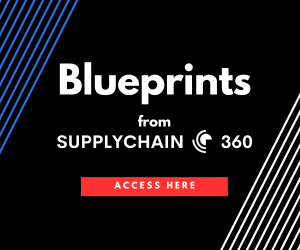
supply chain technology series
Technology Integration & Data Analytics
BLUEPRINTS
Predictive analytics for dynamic route optimization is a game-changer in logistics, addressing the critical challenge of optimizing delivery routes in real-time. As supply chains grow increasingly complex, the need for efficient, adaptive routing becomes paramount to reduce costs and improve service quality.
This blueprint provides a comprehensive guide to implementing predictive analytics, equipping supply chain directors with practical steps and proven strategies. By following this blueprint, you can tackle complex routing issues, minimize delays, and enhance customer satisfaction.
The benefits of using this blueprint include increased efficiency, reduced fuel consumption, lower delivery costs, and improved on-time performance. It’s your roadmap to smarter logistics operations.
Step-by-Step Guide for Implementing Predictive Analytics for Dynamic Route Optimization in Logistics
Step 1: Data Collection and Integration
Identify Data Sources
- Determine all relevant data sources, including GPS tracking, weather information, traffic data, order volumes, and vehicle performance metrics.
Implement IoT Sensors
- Equip logistics assets with IoT sensors to capture real-time data, such as vehicle location, engine status, and fuel consumption.
Consolidate Data
- Use data integration tools to centralize information from various sources into a single, unified system. Consider using platforms like Apache Kafka or Talend for data integration.
Data Quality Checks
- Establish protocols for data validation and cleaning to ensure accuracy and reliability. Common practices include removing duplicates, addressing missing values, and standardizing formats.
Step 2: Data Analysis and Model Development
Select Analytical Tools
- Choose appropriate software for data analysis and model development. Options include R, Python with libraries like scikit-learn, or dedicated platforms like SAS.
Develop Predictive Models
- Create models that predict traffic patterns, delivery times, and potential disruptions. Machine learning algorithms, such as regression, decision trees, or neural networks, can be employed based on the complexity of the logistics network.
Cross-Validation
- Apply cross-validation techniques to ensure model robustness and avoid overfitting. Consider k-fold cross-validation or leave-one-out cross-validation.
Parameter Tuning
- Adjust model parameters for optimal performance. This can include grid search, random search, or Bayesian optimization.
Step 3: Implementation Strategy and Integration
Develop an Implementation Plan
- Outline the steps to deploy predictive analytics in the logistics network, considering timelines, resources, and milestones.
Integrate with Existing Systems
- Ensure compatibility with current logistics management systems. Use APIs or middleware to facilitate seamless data exchange.
Conduct Training Sessions
- Provide training for key stakeholders on the use of predictive analytics tools and interpreting results. Include hands-on workshops and reference materials.
Create a Feedback Loop
- Establish a mechanism for continuous feedback and improvement. Regularly collect insights from drivers, dispatchers, and other logistics personnel.
Step 4: Dynamic Route Optimization Deployment
Define Optimization Criteria
- Identify the key factors for route optimization, such as distance, delivery windows, fuel efficiency, and customer preferences.
Implement Real-Time Analytics
- Deploy real-time analytics to monitor traffic conditions and adjust routes dynamically. Use platforms like Google Maps API or TomTom for real-time traffic data.
Optimize Routes
- Utilize route optimization algorithms, such as the Traveling Salesman Problem (TSP) or Vehicle Routing Problem (VRP), to find the most efficient paths.
Incorporate Predictive Elements
- Use predictive models to anticipate traffic congestion, road closures, or adverse weather conditions and proactively adjust routes.
Step 5: Monitoring and Continuous Improvement
Track Key Metrics
- Monitor essential KPIs, such as delivery times, fuel consumption, and on-time performance. Implement dashboards to visualize real-time data.
Analyze Performance
- Conduct regular analysis to identify trends, outliers, or areas for improvement. Use statistical techniques like control charts or time series analysis.
Iterate and Optimize
- Make data-driven decisions to refine route optimization strategies. This could involve changing delivery schedules, adjusting routes, or reallocating resources.
Leverage Machine Learning
- Apply machine learning techniques to continually improve predictive models and enhance route optimization over time. Use reinforcement learning to adapt to changing conditions.
This step-by-step guide provides a comprehensive approach to implementing predictive analytics for dynamic route optimization in logistics. Each step is designed to be actionable and detailed, ensuring clarity for supply chain directors.
Best Practices
Implementing predictive analytics within supply chain operations requires a strategic approach to ensure success and avoid common pitfalls. Here are some best practices to follow:
Start with a Clear Vision
- Define Objectives: Clearly articulate the goals of implementing predictive analytics in the supply chain. These could include reducing delivery times, optimizing routes, or improving fuel efficiency.
- Align with Business Strategy: Ensure that the objectives align with the overall business strategy to gain buy-in from stakeholders.
Invest in Data Quality
- Data Governance: Establish robust data governance policies to maintain data accuracy, consistency, and security. Appoint a data steward to oversee these processes.
- Regular Data Audits: Conduct periodic audits to identify and address data quality issues, such as missing or incorrect data.
- Data Integration: Ensure seamless data integration across systems to avoid information silos. Use ETL (Extract, Transform, Load) processes to streamline data flow.
Foster Cross-Functional Collaboration
- Involve Key Stakeholders: Engage stakeholders from different departments, such as logistics, IT, and operations, early in the process. This promotes a collaborative environment and enhances implementation success.
- Regular Communication: Establish regular communication channels to keep stakeholders informed about progress and address any concerns.
Prioritize Training and Skill Development
- Comprehensive Training Programs: Provide comprehensive training for all personnel involved in the implementation, from data analysts to logistics managers. Include both theoretical and practical sessions.
- Skill Development: Encourage ongoing skill development to keep up with the latest trends in predictive analytics. Offer opportunities for certification and advanced training.
Focus on Continuous Improvement
- Feedback Mechanisms: Implement feedback mechanisms to gather insights from employees on the ground. This helps identify areas for improvement and fosters a culture of continuous learning.
- Regular Performance Reviews: Conduct regular performance reviews to assess the effectiveness of predictive analytics in achieving supply chain objectives. Use this feedback to refine processes and strategies.
Ensure Compliance and Security
- Compliance with Regulations: Adhere to industry regulations and data protection laws to avoid legal complications. Stay updated on changes in compliance requirements.
- Data Security Measures: Implement robust data security measures to protect sensitive information. Use encryption, secure access controls, and regular security audits to safeguard data.
These best practices are designed to ensure successful implementation and maximize the benefits of predictive analytics within supply chain operations. Following these guidelines can help mitigate risks and promote a smooth transition to data-driven decision-making.
Tools and Technologies
Predictive analytics for dynamic route optimization in logistics relies on a range of essential tools and technologies. These support the collection, analysis, and integration of data to enhance supply chain efficiency. Below is an overview of the most important tools and their key features.
Data Integration Tools
- ETL Platforms: Tools like Talend, Informatica, or Apache NiFi facilitate Extract, Transform, Load (ETL) processes. They allow data from various sources to be consolidated into a unified system, streamlining data management.
- Benefits: These tools ensure data consistency and reduce manual data handling errors. They also support real-time data integration, crucial for dynamic route optimization.
Data Analytics and Machine Learning Platforms
- Analytical Tools: Platforms like R, Python (with scikit-learn and TensorFlow), and SAS offer extensive capabilities for data analysis and machine learning. They support a variety of predictive models, from regression to neural networks.
- Benefits: These platforms enable users to create, train, and deploy predictive models. They also have robust visualization features to help interpret data and make informed decisions.
- Integration: These tools can integrate with data warehouses and business intelligence (BI) tools for seamless analytics.
Real-Time Traffic and Route Optimization Tools
- Traffic Data Platforms: Solutions like Google Maps API, TomTom, or HERE provide real-time traffic information, enabling dynamic route adjustments.
- Benefits: These platforms offer accurate and up-to-date traffic data, allowing logistics teams to make informed routing decisions. They can be integrated with existing route planning systems for automatic adjustments.
- Route Optimization Software: Tools like Route4Me or OptimoRoute offer algorithms to optimize delivery routes, considering multiple factors such as distance, fuel consumption, and delivery windows.
- Integration: These tools often have APIs to integrate with other logistics management systems, facilitating real-time route adjustments.
IoT and Telematics Solutions
- IoT Sensors: Devices like GPS trackers, fuel monitors, and temperature sensors provide real-time data from logistics assets.
- Benefits: These sensors enable continuous monitoring of vehicles and cargo, allowing predictive analytics to be more accurate and timely.
- Integration: IoT solutions can integrate with data analytics platforms, providing a steady stream of real-time information.
These essential tools and technologies are critical for successful predictive analytics implementation in logistics. They offer a comprehensive solution for data integration, analysis, and real-time route optimization. By leveraging these technologies, supply chain directors can improve operational efficiency and decision-making.
Key Metrics and KPIs
To evaluate the success of predictive analytics for dynamic route optimization, supply chain directors should focus on specific key metrics and KPIs. These metrics offer insights into operational efficiency, cost savings, and customer satisfaction. Here’s a concise overview of the essential KPIs and how to track and interpret them:
Delivery Time and On-Time Performance
- Definition: Measures the time taken for deliveries and the percentage of deliveries completed within the scheduled time.
- Tracking: Use GPS tracking and delivery management systems to monitor delivery times. Implement dashboards to visualize on-time performance trends.
- Interpretation: Consistently meeting or exceeding delivery timelines indicates effective route optimization. Deviation from expected times could suggest delays or inefficiencies.
Fuel Consumption and Efficiency
- Definition: Tracks the amount of fuel used by the logistics fleet and calculates fuel efficiency (miles per gallon or liters per kilometer).
- Tracking: Utilize telematics and fuel monitoring systems to collect data on fuel consumption. Implement IoT sensors to capture real-time fuel usage.
- Interpretation: Lower fuel consumption and higher fuel efficiency suggest optimal route planning. Significant variations may indicate inefficient routes or vehicle issues.
Cost per Delivery
- Definition: The total cost associated with each delivery, including fuel, vehicle maintenance, and labor.
- Tracking: Integrate cost-tracking software with logistics management systems to capture all related expenses. Use business intelligence tools to analyze trends.
- Interpretation: A decreasing cost per delivery indicates improved efficiency. Increases in cost may require investigation into operational inefficiencies or rising overheads.
Customer Satisfaction and Feedback
- Definition: Measures customer satisfaction with the delivery process and collects feedback on service quality.
- Tracking: Implement customer feedback surveys or net promoter score (NPS) systems to gauge satisfaction levels.
- Interpretation: High customer satisfaction reflects successful route optimization and service quality. Negative feedback could highlight areas for improvement in delivery accuracy and timeliness.
These key metrics and KPIs provide a comprehensive framework for assessing the success of predictive analytics in logistics. By consistently tracking and interpreting these indicators, supply chain directors can make informed decisions to optimize operations and enhance customer satisfaction.
Implementing predictive analytics for dynamic route optimization in supply chains can present a variety of challenges. These obstacles can stem from technical, operational, or organizational factors. Here are some common challenges and practical solutions to help overcome them:
Data Quality and Consistency
Implement robust data governance practices to ensure data quality. Conduct regular data audits and establish clear protocols for data cleaning and validation. Use ETL tools to automate data integration and maintain consistency across systems.
Resistance to Change
Foster a culture of collaboration and inclusion by involving key stakeholders early in the process. Offer comprehensive training and communicate the benefits of predictive analytics to encourage adoption. Implement a phased approach to ease the transition.
Integration with Legacy Systems
Use middleware or APIs to bridge the gap between legacy systems and new analytics platforms. Consider a gradual migration to modern systems that offer greater flexibility and scalability. Work with IT teams to ensure seamless integration and minimize disruptions.
High Implementation Costs
Develop a detailed budget that accounts for all implementation costs, including potential contingencies. Seek cost-effective solutions, such as open-source software or cloud-based platforms, to reduce expenses. Explore partnerships with technology vendors for favorable pricing and support.
Security and Compliance Risks
Implement robust data security measures, such as encryption, secure access controls, and regular security audits. Ensure compliance with industry regulations and data protection laws, such as GDPR or CCPA. Train employees on data security best practices to reduce the risk of breaches.
Inconsistent Results
Establish a continuous improvement process that allows for regular model updates and recalibration. Use cross-validation techniques to test model robustness. Implement feedback loops to gather insights from logistics teams and adjust models accordingly.
These challenges are common in supply chain implementations, but with careful planning and the right solutions, they can be overcome. By addressing these obstacles, supply chain directors can ensure a smoother transition to predictive analytics and achieve the desired outcomes.
Using this blueprint, can unlock the benefits of predictive analytics for dynamic route optimization. By implementing its step-by-step guide, you can streamline delivery operations, reduce costs, improve customer satisfaction, and enhance on-time performance. This blueprint offers practical insights to help you stay ahead in today’s fast-paced logistics landscape.
Unlock more insights and innovative strategies for your supply chain. Subscribe to SupplyChain360 today and gain exclusive access to a wealth of blueprints, tools, and expert resources.





